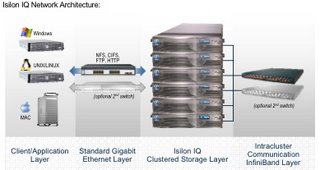Part II: More new storage arrays
Isilon Systems
Isilon is one of the vendors doing Clustered Storage in the form of 2U NAS bricks that interconnect with each other through Gig Ethernet or Infiniband and include a Shared Filesystem that lets them share and balance files across the shared disk space. They focus on very similar servers and workloads as Panasas and BlueArc - scaleable rack servers requiring high-bandwidth access to large files although their material talks about the market differently. It describes the growth of Unstructured Data - large multimedia files requiring high-bandwidth, shared access - essentially the same as HPTC.
Here is the picture from their White Paper:

Their 'secret sauce' is their Distributed File System (DFS) which uses a Distributed Lock Manager (DLM) over the dedicated interconnect which can be either IB of Ether. The DFS integrates volume management and RAID including Reed-Solomon ECC so it can tolerate multiple disk or node failures within a volume/stripe. The DFS handles distributed metadata and file locking so multiple nodes can share access to a file. Includes the ability to rebalance data across nodes to maintain load balancing and something they call 'smartconnect' which a source tells me looks a lot like basic IP path failover and load-balancing. Also provides one integrated view of the data for the management UI. The host interface includes NFS, CIFS. No mention of iSCSI at this point.
One issue I didn't see addressed is how they handle failover when a box fails. Using their EDD/RAID algorithms, the data is still there, but clients will have to re-mount the volume through new IP address. I suspect this isn't handled today. Something like a pNFS MDS is required for that.
Summary/Thoughts
Another approach to address similar problems and market as Panasas and BlueArc. Uses commodity HW, like Panasas, but uses existing standard NFS/CIFS for the SAN interface like BlueArc. I saw a reference to them on the web using embedded Linux but someone told my they use a version of BSD. Either way, they should be able to quickly pick up NFS/pNFS enhancements as they evolve while they focus their engineering on enhancing the DFS and management UI. The biggest threat is that open-source Linux DFS's will eventually catch up and standards like pNFS eventually eliminate the need to embedded a DFS in the storage. For now though, looks like a promising approach (provided they've worked out all the failure conditions).
LeftHand
Lefthand is also doing 'Clustered Storage' using rack-mount storage trays built from commodity hardware, SAS and SATA disks, and ethernet interconnect. Like Isilon, they have a distributed file system allowing them to share data, stripe & RAID protect across multiple bricks, and scale to many bricks. Lefthand also distributes their metadata processing so there is no single-point-of-failure.
Lefthand offers a NAS interface although I think most of their installed-base is iSCSI and that's where they focus. One unique feature is they've developed a multipath driver that keeps a map of all the alternate controllers that could take over serving a LUN when one fails. Good idea. I've seen some PR recently about certifying with Windows for iSCSI boot. I don't know how far they've gone with implementing automated services such as DHCP and DNS as I described in my Ideal SAN, but that would support their value prop as a leading provider of iSCSI-based SAN Solutions.
CrossWalk
Crosswalk was founded by Jack McDonald who started McData and it looks like they are leveraging their switching heritage. Technically, not an array provider, but they use similar technology and are focusing on similar problems - aggregating storage together into a 'grid' with a global namespace and high availability, scaleability, etc.
Crosswalk is clearly focusing on the HPTC market and I applaud their marketing for being clear about their focus on this segment. Nearly every marketing book I've read and class I've taken makes it clear that segmenting your marketing and defining your unique advantage in that segment is a fundamental requirement for success. Despite this, in my twenty years in storage I've met very few product managers willing to do this ("we might lose a sales opportunity somewhere else...."). But, I digress.
Crosswalk also uses a distributed file system that aggregates data into one namespace, allows shared access to information, implements a DLM, etc. Crosswalk differs in that they take the approach of doing this in an intermediate layer between the storage and the IP Network. Their product is a small grid of high-performance switches serving NFS/CIFS on the front and using legacy FC storage on the back-end. This is their differentiation: "integration of disparate storage resources". Presumably, they leverage their experience at McData implementing high-performance data channels in the box so they can move lots of data with a relatively few nodes in their 'virtualization grid'. Host interface is standard NFS/CIFS.
Given their focus on HPTC where Linux prevails, I would hope they use Linux in their grid and can pick up NFS/pNFS enhancement as they are adopted on HPTC grids. Also, given that 30% of the top-100 supercomputers now use Lustre from ClustreFS, and given their location just down the road from ClusterFS in Boulder, I would assume they are talking. This would make a good platform for running the Lustre OSD target.
Equallogic
Sells 3U and 4U iSCSI arrays. Found limited information on the website about the internal architecture but appears to be block (no NFS) with the usual set of data services. Also talks briefly about some unique data services to let bricks share data and metadata for scaling and availability but it doesn't sound like the same level of sharing as Isilon, Crosswalk, or Lefthand. This looks more like a straightforward, iSCSI block RAID tray. Nothing wrong with that. Over the next several years, as the RAID tray becomes what the disk drive was to the enterprise ten years ago, they are one of the contenders to be one of the survivors, provided they can keep driving down HW cost, manufacturing in high volume, keep reliability high, and keep up with interconnect and drive technology.


<< Home